This is the first in a series of articles looking back at suits I have had made by the world’s major tailors, and examining their style through a consistent set of parameters and images.
For background and context, see the introduction here.
House: Richard Anderson
Address: 13 Savile Row, London
Site: www.richardandersonltd.com
Cutter: Richard Anderson
Price (at time of writing): £7860 (incl VAT)
Suit starting price: £5904 (incl VAT)
Richard Anderson cut me this three-piece, peak-lapel tuxedo in 2014. I really enjoyed talking with Richard, and particularly Brian [Lishak] about the style aspects of the tux.
Although Richard’s output is always expanding, the atmosphere at 13 Savile Row remains cosy, with everything under Richard’s watchful eye.
It is more similar in some ways to the Italian houses that are organised around a single master cutter, than to the other houses on the Row.
For my tux I opted for a mohair/wool cloth, tempted by the sharpness of the mohair, and in black rather than the now more fashionable midnight blue.
I don’t regret the black, and the mohair has remained crisp, but in retrospect I think I might have enjoyed a pure wool more. Mohair doesn’t have the same drape or age as nicely.
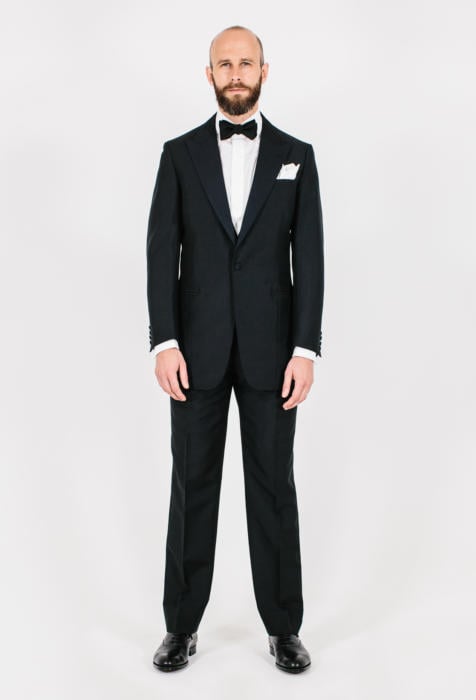
Richard, of course, was at Huntsman for a long time, at the end as head cutter, and his style is similar to their classic cut.
Compared to other English tailors, the style is perhaps best described as understated: straight up-and-down, without any exaggerated lines or sharp cutaways.
The shoulder, for example, is relatively narrow, finishing before the outer edge of the deltoid muscle.
The lapel is relatively narrow for a peak, at 3½ inches, and that peak fairly small. The gorge sits almost 5 inches from the shoulder seam, which average for Savile Row, but low by the standards of many contemporary suits.
The quarters (below the waist button) are quite closed, and the hips cut neat.
So Richard’s style is quite modest in that where another tailor might use some combination of extended shoulders, wide lapel and open quarters to create more of an ‘X’ shape across the body, he does not.
[For an illustration of the different parts of the jacket, and their tailoring terms, see the introduction to this series here.]
The jacket’s shoulder has a moderate-sized pad (for an English tailor) and finishes quite naturally at the sleevehead, running smoothly into the sleeve and down the arm.
Some tailors would try to create an impression of width here by using sleevehead roll (padding and often canvas) to lift up the top of the sleeve.
The jacket is quite long (one of the longest I have, at 32¼ inches) which is consistent with the Huntsman style.
The buttoning point is quite low on the body, but normal in proportion to that length.
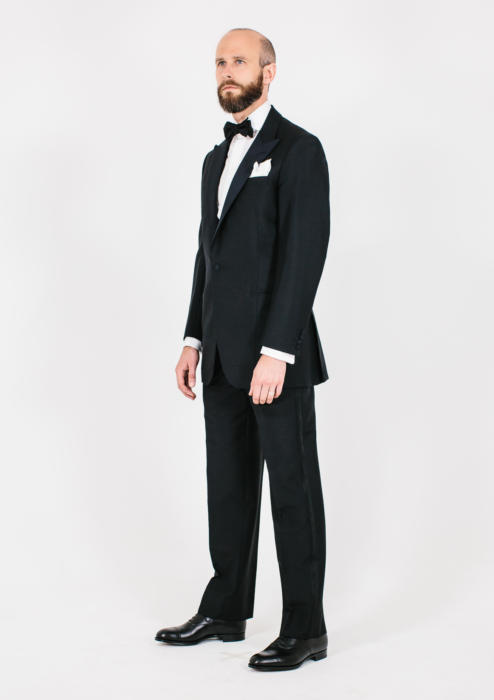
Interestingly, the jacket has a little drape in the chest, although nothing approaching the tailors known for such drape, such as Anderson & Sheppard.
The lapel is cut quite straight, with a little ‘round’ towards the top. (Generally, ‘belly’ is used to refer to a fuller shape at the bottom of the lapel, ‘round’ to shape at the top.)
Both these things could be used to give an impression of fullness or roundness to the chest.
Elsewhere, not too much shape has been put through the back of the jacket.
I have quite a hollow lower back, and tailors vary as to how far they want to highlight it. Richard kept it relatively hidden, with the back seam quite straight.
The sleeve width is pretty standard, though the cuff is relatively narrow (11 inches). And the vent is a touch shorter than average (10 inches).
In terms of make, the buttonholes are slim and neat – fairly standard for good West End suits – and the grosgrain facing (on the lapels) has been put on by hand.
The work inside is also good and standard for the Row. Lining attached to the facings by hand, side seams in the lining by hand, centre seam by machine.
In the chest there will be a layer of body canvas running the length of the body, a layer of horsehair just at the top, and then domette over the top of that.
Jackets generally have two darts or cuts on either side at the front, to help create shape through the waist.
Which of those they are, however, and which one (or neither) extends below the pocket to the bottom edge, varies considerably between tailors.
Richard’s jacket has a front cut that runs all the way to the bottom (above – the line running through the pocket), and a dart behind it that runs from the armhole to the pocket.
This is a little unusual for Savile Row tailors, who are more likely to have a dart or cut at the front that ends at the pocket, and a cut behind that that runs all the way to the bottom edge (creating a ‘side body’ between that cut and the side seam).
As mentioned in the introduction to this series, I won’t comment on the style of the waistcoat (as there are hardly any to compare it to among my suits) and only mention the measurements of the trousers in the list below.
Overall, I’ve been pleased with how my tux has worn.
The only question mark for me is whether a more dramatic style might be more suited to evening wear.
That is very much a matter of taste, however, and others might see this modest, understated style as perfect for something that – at heart – is meant to be elegant and simple: an accompaniment to any female companion, rather than a rival for attention.
Style breakdown
- Shoulder width: 6 inches
- Shoulder padding: Moderate
- Sleevehead: Natural, no sleevehead roll
- Sleeve: Moderate, narrow cuff
- Lapel: 3½ inches, straight
- Gorge height: 4¾ inches
- Drape: Small
- Outbreast pocket height: 10 inches (shoulder seam to bottom of pocket welt)
- Buttoning point: Low, 20 inches from neck point
- Waist suppression: Moderate
- Quarters: Relatively closed, straight
- Length: 32¼ inches
- Back seam: Quite straight
- Vent height: 10 inches
- Trouser width at knee: 19½ inches
- Trouser width at cuff: 16½ inches
Photography: Jamie Ferguson @jkf_man
Worn elsewhere:
- Grosgrain bow tie and linen pocket square: Anderson & Sheppard
- Black toe-cap oxford shoes: ‘Chelsea’ from Edward Green
- Bespoke white silk shirt: D’Avino


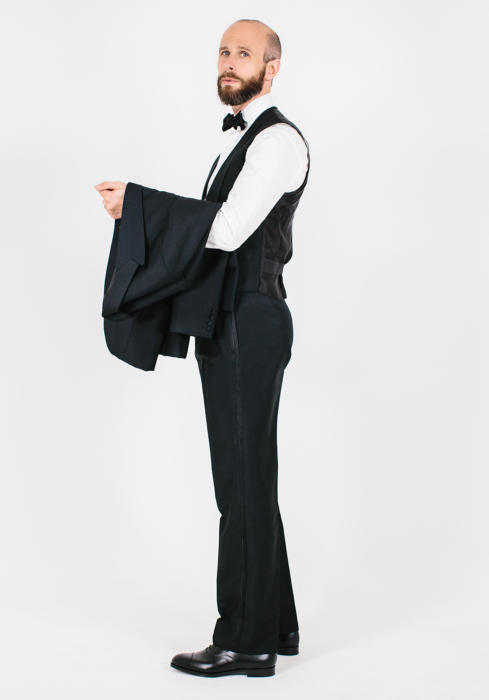
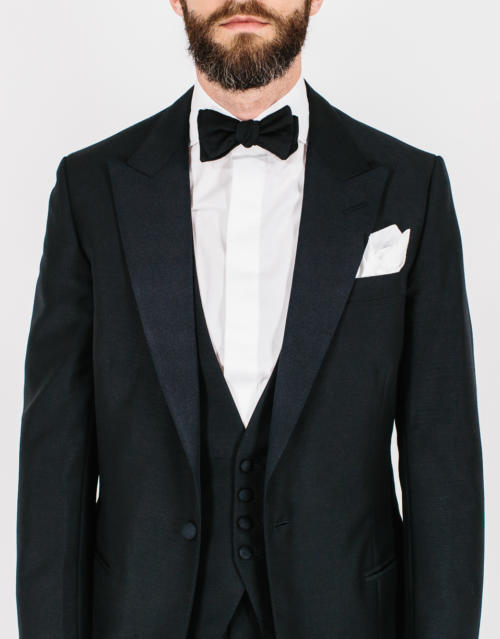
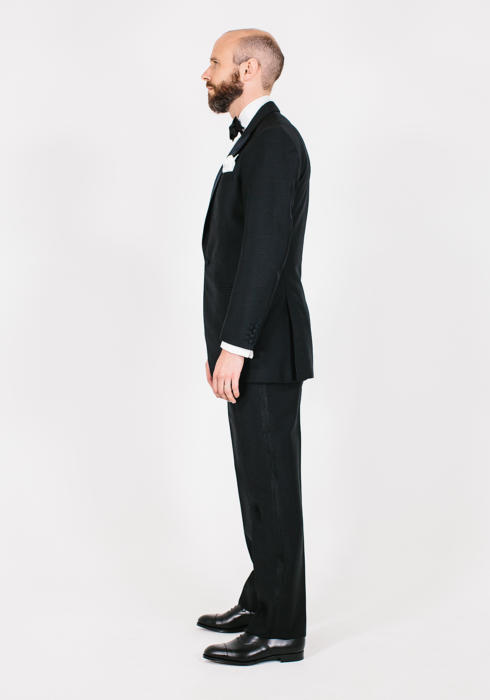
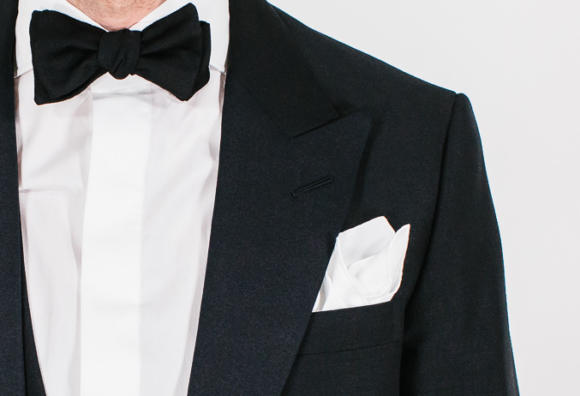
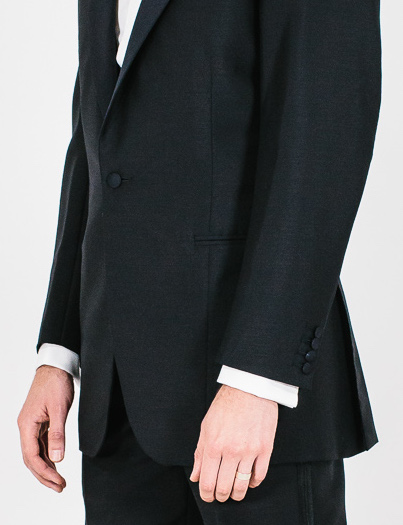
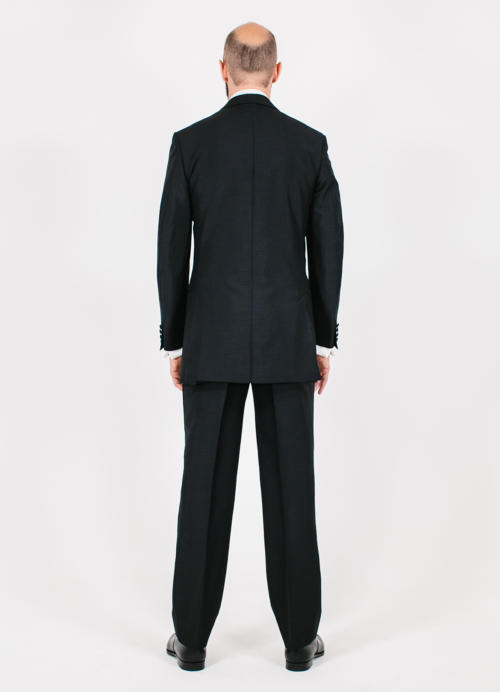
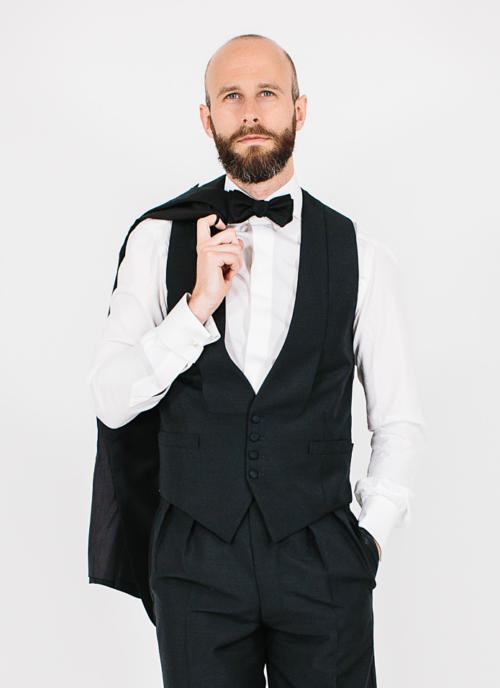
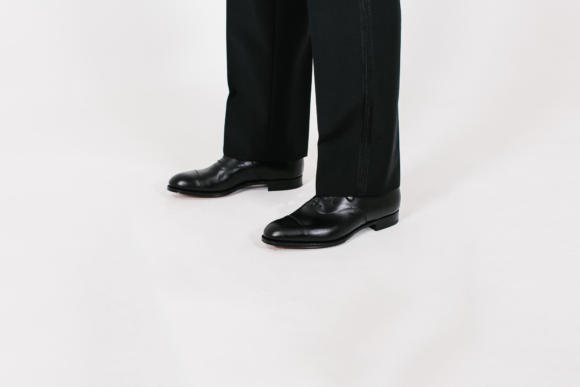


























Price (at the time of writing)… is that correct, its the price it would be today (given you’ve written this article today)? Having an updated price rather than 2014 is great but feels more onerous than saying what its price was at the time you had it made.
Yes, it’s the price it would be today. It didn’t seem that relevant to quote the price from four years ago, given you can’t pay that any more!
Would you ask Richard to change anything on the suit if you had it made today?I just wonder if your ideas on style have altered much over the years.For example,are you still happy with the jackets length or the width of the trousers bottoms,say 15″ today?
Good question.
I would probably narrow the trousers slightly, yes.
I would leave the basics like jacket length the same, but I might ask for a slightly broader lapel perhaps – as mentioned, that’s very much a question of taste though. I would also generally say, as I always do, that you shouldn’t start trying to change the house style into something it’s not – eg trying to redraw the lapel, with more belly etc.
Here goes
Sleeves should be 1/2” longer.
Vents kick out.
Coat needs passing up through the back by 1/2”:
Right sleeve isn’t finished well at the back.
More broadly, it’s a Tux on the other side of the pond. Here its a Dinner Jacket.
Thanks
Thanks.
I won’t address any of the fit points, because as stated many times, it’s not possible to make those kind of judgements based on photos like this.
On terminology, you may well be on this side of the pond, but more readers are in the US. I’m happy to use the two interchangeably.
I should also say that, as with everything I do, this series is not done by me in isolation. I chatted to tailors about all these suits.
They suggested one or two alterations, but none of the ones you list. So I suggest we leave it to them rather than remote speculation.
Thanks
Well said…
Was going to say, I always think Black Tie looks best with a slight military cut trouser – tapered and a slight angle at the hem. Thoughts?
Interesting. Why more on black tie? Do you think it looks more formal?
Exactly, a sharp look that’s distinctive without being flash
I think the trouser width is fine. Look at the side photo. Perfect fit. They just bellow out slightly sideways because of the way you’re standing. Perhaps they could be held up by braces. I find it gives a cleaner line down the crease.
Otherwise, it’s a matter of personal taste.
A question on prices. Why do you give a price and a starting price? Would the latter be the minimum price with the cheapest fabric?
No, the starting price is for a 2-piece suit, not a three-piece tux
I see. Thank you.
Beautiful but a heck of a price. Apart from James Bond I can’t see many people getting the wear out of a tux that could justify such an outlay.
Good point – harder to justify these things with less intensely used pieces
I find the events at which I wear my dinner jacket are usually pretty warm. What weight cloth did you select?
I can’t remember, let me check. That is one reason to select a mohair mix though – mohair is good for warm weather
Does an X shape necessarily require extended shoulders? I have so far only considered the opening of the quarters , the shape of the opening of the lapel and the buttoning point.
It doesn’t require it, no. None of those things are required for an X shape across the body. But each one accentuates it
Hi Simon
I find most traditional English tailors aim for a Y rather than an X unless asked to to otherwise.
I like the pleats on the trousers; they look very well made.
Final point, whilst it’s evident you don’t much like it when people are critical of something on this site, I think anonymous is pretty accurate with his comments on fit based on the pictures.
Thanks Toby, that’s a nice way of putting it. I think we’ll see over the series that there is some interesting variation among the English too
On the anonymous comment, yes that is what the pictures look like. But given that, as I said, a very good cutter has seen it in the flesh and disagrees on all the points, I think we can safely say the pictures arent a very good guide
For a cutter to see it and disagree with all my points so soon after I made them is impressively quick work Simon.
They didn’t disagree after, they disagreed before. We discussed pretty much every possible aspect of fit and style
Interesting. Traditionally a dinner jacket is ventless. Was the decision to cut a vent your choice, or was this Richard Anderson’s default?
My choice. I like the extra lines created by the vents (not too dissimilar to the X point above) and a ventless jacket is hard on me given the contrast between scooped lower back and prominent seat
I really like the details of this suit. For a dinner jacket I would prefer a more dramatic cut since it’s one of the types of jackets where it works best, but I know this follow’s Anderson’s house style. Your desire for wider lapels would certainly give a more dramatic look.
Interesting how you describe the peak lapel as being narrow, since it doesn’t look that way overall. By the measurement it sounds narrow, but the lapels look like a healthy width because the shoulders are narrow.
The front dart extending to the bottom used to be more common with English tailors before the sidebody became popular. Now I rarely see it outside of Neapolitan tailors.
How has mohair aged not as well as wool would have? I would really like a mohair-blend dinner suit because I mostly wear black tie in the summer (and I’m always too warm), but now I’m curious if 100% wool barathea is still the way to go.
Good point on the relativity of the lapel Matt.
The mohair seems to have shined up a bit, but the bigger point really is just that I dislike the way it feels a little. A bit too crisp if you know what I mean?
Simon,
The price quoted for a dinner suit is ludicrous. What is going on with price inflation in bespoke today? In the UK there’s barely been inflation and certainly no real wage increases in the last ten years. Yet bespoke (be it shirts or suits) increase over 10% a year. I wonder if a limit will be reached soon. No matter how good you income is, at some point spending so much on an item of clothing becomes absurd.
And again this brings me back to GB. In the last ten years their price increases have been very small, barely keeping up with general inflation, yet they are based in London and should be exposed to a lot of the cost increases SR are.
It would be interesting to see more from you reflecting on this. When ia enough enough when it come to prices?
S
Sure, its an interesting area. One cause is rents in Mayfair, which have gone up hugely in the past 10 years. In some cases they’ve almost doubled. The kind of unit we had on the other side of the Row might cost you over £200k a year
Thanks Simon. And that begs the question, when does it stop being worth paying for the insane rents at SR? Most (if not all) of the good cutters, with a very, but prominent exceptions, have retired anyways so it is not as if SR offers any advantage in cut as opposed to many other places.
And interestingly John Kent, who is one of the last of the old guard, charges way less (as in several thousand pounds) for a suit / dinner suit than what is quoted here. And his / Terry Haste’s style would be very similar to this and handwork / make obviously the same.
I think the price increasea not only relate to increased rent but availability of a new group of customer (Asians etc) who are more price insensitive. In addition the decline of the pounds vs major currencies allows for prices increases in sterling which seem less steep in say USD. Stees, which ia very US focused, have used this to raise their prices over 50% in the last few years.
Will be interesting to see when this will stop. SR is clearly already “dead” to actual Britons.
S
Thanks S. Generally agree, though it’s not the case on the cutters really. Some very talented cutters indeed working at all the various houses
It’s not just rents or overheads. It’s much deeper. In today’s world, tailors want to increase profit margins. They needed to position themselves in the top-earning bracket and the world of easy money when they made the transition from craftsmen to artists/designers. You’ll be having a debate on the media and tailoring soon. I put it to you that social media and the iGent explosion have only made it worse. Customers want “design”, the tailor therefore becomes a designer, and charges designer prices.
Thanks, that will be an interesting point to discuss. To be honest, my view is that Row tailors don’t think enough about design – nothing revolutionary, just small cut points.
Also, these are still a long way from designer prices. A good example is a designer brand I know that uses a separate bespoke tailor for their bespoke offering. The tailor on their own charges 5k; the brand sells the same product for 8k. That’s a designer price for this quality of product
If you can afford to spend the thick end of £8,000 on a suit then average wage increases and inflation aren’t likely to have much of a baring on your income.
Also remember that a substantial proportion, if not a majority, of the suits sold by Savile Row houses are being made for overseas customers, who will be completely unaffected by the sluggish performance of the UKs economy and are also benefitting from a more favourable exchange rates.
I get what you mean about it being too crisp. It’s not going to feel as nice as 100% wool. But I love the way it looks here, though the trouser especially don’t drape as well as they would with wool. Do you know what the percentage of mohair in the fabric is?
It’s around half I think
I think a bit of mohair in the mix is a good idea for a DJ as it adds the merest hint of a sheen, which I like.
I agree though that 50/50 might be a little too much; 20% mohair is probably about right.
Half mohair must be why it hasn’t worn as well. 15% mohair probably would be ideal, though it wouldn’t look as unique.
This series will be a great reference work for years to come. Many thanks!
An excellent start to what promises to be a really informative series. Your illustrated explanation of Richard’s house style plus the current pricing have certainly helped me slim down my shortlist!
Hi Simon,
I think overall the suit is excellent.
As regards the price, I don’t know how old you are but from your photographs I would thin that suit woul be good for another 20years.
Edward Sexton made me a three piece dinner suit in 1983, very similar to yours, slightly wider lapels , 18 trouser bottoms, relatively timeless.
I still wear it regularly, I prefer it my other dinner suits ,it’s nearly always commented on and I still am delighted to wear it.
By the way, it’s Midnight Blue which in my opinion is the default colour for a dinner suit.
Regards
Stephe
Great start to this series. I’m really looking forward to other episodes. I have a summer tailor and an “everything else” tailor that I’m very happy with but it’s fun to compare styles.
What’s your opinion on double breasted dinner jackets?
I like them, particularly as it means you don’t need a cummerbund or waistcoat. And because a DB can be very flattering but hard for some to wear in offices
Firstly thanks for taking the time to re-visit this selection. Great images too. I disagree with the comments re. the cut – it’s excellent as you would expect from Richard. My issue is more to do with style; it’s complex with idiosyncrasies that don’ quite chime. For example the double pleats vs. full leg, the waistcoat shape is uncertain; low gorge but with a v – rather than scooped. If it had been higher (sternum) the v would compliment the cut. I understand why it is cut this way (to match the jacket line) but why then use at all? Lastly, knowing your taste for restraint I understand the lack of silk facing on the lapel but it does look a little bare and therefore lacks synergy with the trousers (as, correctly, they have silk side braiding). None of this is really a problem but as time goes by and fashions change I question whether the hybrid approach will retain its style or look out of place. Personally I would consider some form of trim or facing on the lapels and get (if required) a new waistcoat cut. Keeping to classical styles in evening wear (peaked lapels and scooped waistcoat stylistically speak of 1920’s through to 1950’s) ensures greater longevity and thus greater value from the garment.
I’m a bit confused at these comments because everything here is done by the book. The lapels on the jacket have silk facings, it’s just that the body has so much sheen that there’s not much contrast with the lapels. Or are you talking about the waistcoat lapels? Traditionally they may take the same facings as the jacket or may be self-faced (which is what they appear to be here). And the waistcoat is entirely traditional. The gently curved V-shape is just as traditional as the U-shape. A higher opening (there’s no gorge on the waistcoat because there is no collar) would not be traditional, since any waistcoat with black tie should be almost completely hidden with the jacket buttoned.
Thanks. The lapels are self-faced, and I think that was what was being referred to. Not clear though
Do the jacket lapels not have the grosgrain facing that you mentioned? Grosgrain would certainly look very subtle against a mohair suit.
They do, yes
A very elegant suit.
Beautiful lines, understated and completely flawless.
You could wear this in twenty years time and it would still look this good.
The epitome of ‘Permanent Style’. Don’t alter a thing.
Cloth type is obviously a question of climate and choice.
I‘m looking forward to this serie! It looks very promising and is certanly something that hasn‘t been done before on such a big scale.
On another note:
If you were a groom and would wear this in the evening, what would be your footwear of choice? Captoes as you wear it here, Wholecuts or Opera Pumps? Many thanks in advance.
Well, I wouldn’t wear a tux for a wedding, but I know it’s more culturally appropriate in the US.
I’d wear cap toes or wholecuts.
Simon,
What do you think of Baudoin & Lange Sagans with black tie? They’re somewhat close to opera pumps, but less affected (at least to me, particularly without the little bow tie). In patent leather, they’d seem about right.
Yes, I like them in that setting. They do a whole range of them, but personally I’d quite like just black suede. Never liked patent much – it puts me off that it’s basically a layer of plastic
I also wouldn’t wear black suede sagans with the more formal black tie. I’d always wear an Oxford then
Hi Simon,
This was a very interesting article, thank you. If I may pass on some feedback, I particularly valued your commentary around the “X” shape and what plays into that with this suit, the commentary around how some fullness in the chest is created. That commentary brought real value to the presentation of style points and measurements. Discussion of the side body, darts, and seams by contrast was curious, but the relevance of those was lost on me without commentary of how it impacts the fit or style. I would personally value having most measurements and style points linked into a broader commentary of the impression the suit makes.
A couple more specific questions:
1. As has been noted, the trousers have forward facing pleats. My sense is that with a tuxedo, one normally would have flat front trousers to maximize simplicity. Why were there foreword facing pleats? Is that Richard Anderson’s preference? Did you find that cut fit you better and so you requested it?
2. I could use some explanation of the round and belly. From your blog, you refer to the “cut” as creating it, so I’ve always assumed it had to do with how the outer edge of the lapel is shaped. But I’ve seen other sources seem to describe it as being how much the lapel stands away from the body (i.e. a function of the roll). Can you clarify this for me? Perhaps it is something work adding to the Introduction’s discussion of terminology?
Thanks, and excited to see the rest of this series!
Thanks.
1. The trousers are high waisted with braces and sit on my natural waist. I would pretty much always have pleats for that style of trouser, to help them get up and over the hips
2. It’s the cut, rather than how it stands out or rolls.
Great points on how to make the technical points more relevant. Thank you
Simon
Sent you a posting but I don’t find it.
Not to wear cap shoes with a Smoking. Slip on, pump or patinated please. Cap shoes is for business.
Good courage!
Sorry Herve, didn’t see that one. Thanks for your thoughts
Opera pumps on black tie, in this day and age, are a massive affectation. They’re fine for white tie.
Pleats, particularly forward pleats, are a very traditional style for tuxedo trousers (well, since the 1930s). Trouser pleats are like darts on the front of a jacket; they’re ways of achieving a specific fit rather than to be an extraneous detail like unused buttons or pocket flaps.
Hi Simon,
Regarding the waistcoat: how have you found the fit? I’ve normally seen waistcoats cut a little closer than this, although, you may not care to go jacketless anyway.
Thanks.
I wouldn’t ever go jacketless, no Bruno, and I guess the photo is a little misleading in that respect. But the waistcoat could be fitted a little closer, yes
You challenged my earlier point on fit saying you had discussed all aspects of fit with the cutter and concluded everything was fine.
Now you say the waistcoat fit could be improved.
No I didn’t… I said we had discussed all points of fit and he didn’t consider any of your points accurate. He had other suggestions.
But, in any case here the waistcoat fitting closer or not is not a question of good or bad fit, it’s one of personal choice
I’d be interested to know how much it cost in 2014. It does seem that Savile Row has a much higher rate of inflation than the elsewhere. Any idea why?
A few comments on this above Edward
What’s the fabric swatch? Dinner jacket looks great, well cut, and I understand the choice of mohair blend in black for weight and sheen. Smart choice. Photographs well.
Bob (first comment) raises the issue of cost in 2014. Understandably, as you point out, we can’t go back in time but the point disregards the historical element of cost. Firstly, even in four years, styles have altered so a different cut might be considered – you would therefore be buying a different garment with different considerations. More importantly it provides a fixed reference point of cost as related to the exact garment not an imaginery new one (its like just referencing the cloth you would use now not the actual cloth used). It is understandable that you are providing up to date information but it is not really the point of the article is it? To properly proceed with this excellent catalogue exercise I believe it essential that the relevant detail is properly inventorised. If it were a classic car curation price new and current market value would both be listed. It might be that there is some background discomfort around price inflation but we are all adults and expect prices to rise (to a degree) – especially with the top houses. Lastly please don’t forget to write about the oft forgotten trousers – there is barely a mention until the comments wherein we realise that they come with braces (v. unusual for you as you will appreciate) and hence the double pleats.
Thanks, I’ll certainly try to mention any trouser details. There’s just so much you could go into in a post like this. I guess my aim is to be comprehensive at the level of the style of the cut in the jacket – and then add other interesting points.
I think the width of your trouser bottoms at just over 8″ is fine.There is,to my mind at least,a problem with trousers that shorten to 7.5″ and are meant to be worn with traditional shoes like Oxfords.A 7.5″ hem is too much of a contrast against a large English shoe.Much smaller Continental footwear sits more comfortably against very slim pants.
I know this may sound odd but I think narrow hems and lightweight shoes like your Sagans are a classic pairing but conversely the same trousers with a heavier shoe will look out of date very soon when fashions change.
Interesting, thanks
I was surprised I didn’t like this more. Not that’s it’s a bad piece, not at all, but I had expected more of a flared coat (isn’t that the Huntsman style?) and for me the trousers should be flat fronted and cut a little closer (though Simon has set out his reasons for that). A DJ has to be pretty timeless to justify the low usage I think. I do quite like the low key facing on the coat lapels though, quite stealth. I’d love to get one but can’t justify the price as I’d hardly ever use it sadly.
You’re right, a more flared skirt would be more traditional Huntsman, yes
Simon – thanks for the review, and nice to finally see the RA tux in greater detail.
I will echo your comment towards the end on opting for a more dramatic cut for a garment like the tux. I had a perfectly serviceable one made by Steed many years ago – while the end product looked good, I eventually decided a more dramatic and maximalist look would be better suited to a garment that’s made in neutral colors and is worn in the evening (in dim lighting where the finer points of tailoring are often not that evident).
That thought led to a trek to Joe Morgan, and his more aggressively styled tux sits in stark (and, in my opinion, superior) contrast to the more sedate Steed.
Fascinating discussion, I really appreciate the attention to detail, obviously it’s a worthy topic. In regard to the lapels, how do they compare with the sizing of the lapels on your Chittleborough & Morgan bespoke suit: width and gorge height? I think as a house style C&M they tend to exaggerate theirs so it would be nice to know the difference to get some perspective? Thanks!
I’ll include that suit in an upcoming piece in the series, so a comparison will be possible then. But yes, they are at different ends of the spectrum!
I just thought that the Chittleborough & Morgan suit would be interesting to compare to this, since they are both button one with peaked lapels. I’m very interested now to see how these two suits compare, and I’m glad to find now that I’m not the only one interested in this comparison.
Any notable differences between this and the current Huntsman cut? It has been said that Richard Anderson is more Huntsman than Huntsman, since he was the last cutter who started from scratch apprenticing under Colin Hammick/Brian Hall. I believe no one from Huntsman currently ever even had flow through training from any Hammick disciples like Anderson and likely cuts their own interpretation of the iconic Hammick Huntsman cut. Regarding the tux, looks elegant though I am a bit surprised there isn’t more open quarters as I expected (same goes for the Huntsman tweed shooting jacket).
I couldn’t say I’m familiar with how current Huntsman cutters cut things, but from what I’ve seen I think it’s more similar to the tweed shooting jacket
I guess if one wants a specific cut, best to go with a particular cutter rather than the shop…Huntsman has so many cutters nowadays, with each one having certain variations to the house cut. Main reason why I went to Richard for a commission, you fairly know what you will get and no need to follow the cutter to various houses if he is the owner of the house! Though even his style has evolved from Hammick era.
Thanks SC. In what ways?
Mostly in the shoulder…less padding or “softer” than classic Hammick Huntsman. Though I believe most SR tailors have eased up on padding nowadays. Possibly a little less X shape also as the quarters appear to be a bit more closed and less skirt flare.
Thanks. That would correlate with the padding on this certainly
Simon,
I was reading an article in GQ about Prince Charles, included were some pictures of him wearing a double breasted dinner jacket.
This particular jacket has turn back cuffs on the sleeves which I have never seen before on a dinner jacket. I’m not sure I like it, but it certainly adds interest.
Is this something that used to be more common?
Yes, a bit. It’s also a.personal style thing – he likes the cuffs on other jackets and coats too
Hi Simon – hope you’re well. Quick question – what weight of wool do you think works best for an evening suit in order for it to drape best and last longest? Thanks.
Around 11oz is good, and heavier if you can. There is an emphasis on having these materials light, as it will probably be hot at the event, but if go too light then it just won’t last long – even if it’s something you don’t wear too often
Simon – hope you’re well. A quick question in regard to waistcoat etiquette. It’s difficult to see for sure in the picture on this post and you didn’t discuss it much within the post – but does it matter if you have a collar on evening wear waistcoats or not? And if you do, do they have to match the jacket collar? For instance, with a peaked lapel jacket would a shawl lapel on a waistcoat not work at all? And why did you choose not to have one on yours? Many thanks.
Hi,
In general I would avoid a collar on a waistcoat on something like evening wear when you will rarely take the jacket off. It looks a little fussy and can cause this kind of issue with balancing that and the jacket.
Hi Simon,
Any comment on jacket sleeve length? I notice in this series it varies somewhat from the prescribed 1/4″ to as much as almost 1 3/4″ or 2″ (hard to tell from photos). In some cases it also appears that the cuff is cut slightly higher in the front than in the rear. In this tux it appears to show roughly 1.5″ of cuff. 1/4″ in the Poole, and seemingly even more in the Huntsman tweed, tapering toward the rear. Do you have a preference?
I normally prefer about a half inch. Most of these are around that, most the variety is just photography.
Hi Simon,
Apologies if you have answered this question on a different post. Would you recommend a double breasted jacket as part of the black tie ensemble ?
Thanks.
Yes, absolutely. It can be a very nice excuse to wear a DB, where it might seem too formal in the office these days. Also saves wearing a waistcoat or cummerbund, which you should really do with a single breasted
Exactly my thoughts, Thanks Simon. It’s a good opportunity to wear a double breasted jacket.
The EG “Chelsea” shoes that you are wearing are very elegant.Do you prefer calf to patent shoes with evening wear and if so why?Thank you.
Yes, generally. Patent is just a layer of plastic on top of the shoe, and the texture has no richness or natural variation.
Only a small point…
Could you refer to the “tux” as a dinner jacket? It was after all, invented by Henry Poole and ‘tuxedo’ is named after the tuxedo club in New York nine years later 🙂
Thanks Clive. Personally, to be honest, I’m happy to use them interchangeably. Both were well over 100 years ago, and we don’t hold onto similar linguistic distinctions from that long ago.
Hi Simon,
I am a big fan of your site and style. I was hoping you could provide some assistance with helping me settle on the styling of a tuxedo I’m having made for my wedding. The fabric I selected is a wool/mohair blend in midnight navy, and I will be doing a single button shawl lapel. I would like to get your thoughts on keeping the lapels the same fabric as the tuxedo, as oppose to covering them in grosgrain or satin. I have seen this on a number of cream colored dinner jackets, but would like to get your take on this for a midnight navy fabric. I am not a huge fan of the sheen that comes from the satin lapels and prefer a more matted look.
Also, if you could provide some insight into which tailoring house produces the nicest shape of shawl lapel, that would be greatly appreciated.
Appreciate any feedback you can provide.
-RB
Hi,
If you dislike the sheen of satin (which I do too) then I would go with grosgrain. It’s more traditional and has a nicer texture. I wouldn’t go for self (the same material as the jacket) on a piece like that, personally.
On tailors styles, that’s a really good question but I’m not sure I can help. I’ve never looked at that style from different places, having not made one myself. You may have to search online.
My all-time favourite shape is the wide lapel with large belly at the bottom often used by Purple Label, though.
Hope that helps
I actually met you in person at a Cerrato ‘trouser afternoon’ in London in the summer where I was getting a pair of evening trousers made. Anyway, they have come back and are lovely apart from one aspect I’m unsure about: the excess material that is turned up inside the trousers seems excessive (3.5inches) and gives what I think is a rather bulky finish. As somebody who has had a lot of trousers made by various tailors, what would you suggest is normal/usual in terms of the amount of material turned underneath especially as far as evening wear is concerned?
Many thanks in advance, as always.
Hey Jason, yes I remember you talking about those.
That it is quite a lot to have turned up inside the trouser, but I have had that amount in the past – it’s not unusual.
If it feels too heavy it’s an easy change to reduce it, but always keep a bit in there, at least 2 inches, as you may want to lengthen at some point, or indeed use that cloth to patch or repair somewhere else
Hi,
Might be completely on the wrong thread but couldn’t find a relevant one. My question is the following: when wearing a tropical dinner jacket with shawl lapel, is recommended to use (or not to) a satin cloth on the lapel?
Generally no, the cloth is usually the same as the body (assuming you mean a cream jacket). But you often see them with satin as well
Simon could you explain a little more about the properties of mohair / wool? You said it doesn’t drape or age well. On the drape I assume that this is something to do with the crispness of the fabric? On ageing what happens to it over time? I have a mohair and wool mix jacket in a hopsack and after a year or so of occasional wear it is beginning to shed a little with a slight furring emerging on the surface.
Could I also ask what your height is please? I am trying to work out how the dimensions in these style breakdowns corresponds to your build. Reason being is Im trying to work out a ideal length of jacket for my 6’1 height. My jackets seem to be around 31.5 inches. I’ve found that small changes in length can have dramatic differences in overall look. Not sure if there is a golden rule to work this sort of thing out?
To be honest I don’t know that much on the technical side of the fabric, but I can look into it.
I’m pretty much the same height – just under 6’1″.
There are three main ways to work out jacket length: half the distance from collar of jacket to the floor, the second joint of your thumb (or tucking your hand under it), and covering the seat at the back. But as you’ll see from my series, there can still be up to 2 inches in difference between tailors. Generally, shorter will be more casual. But I’d always want to keep the seat covered
Thank you that would be very interesting to find out Simon. You hear the marketing stuff about Mohair ie the diamond fibre, but never hear about much else) Its so expensive that not many people seem to order it these days. Its very different to wool, I hadn’t realised this before ordering it.
Appreciate the tips on the jacket length. I keep going through phases of preferring a longer jacket then wanting to look more casual and wishing jackets to be shorter! Of course if you have a jacket shortened I think its difficult to have it lengthened again as there isn’t cloth at the front curve so you are stuck.
Dear Simon,
From examples I have seen Richard has a very peculiar double breasted style with narrow relatively straight lapels. As a customer would you try and discuss with him the style of double breasted lapel you like (similar to the Caraceni’s – long wider and with a bit of belly and round) or would you go to another tailor only for the double breasted. For me it sounds odd to accept the tailor’s style in this respect as it would mean having a multitude of tailors for specific garments. What are your thoughts on this?
Peter
If the difference is that large, then yes I would go to a different tailor. Or talk to Richard about what he’s happy doing, and explain you like that different style but would like to stick with him for fit, structure etc
Dear Simon,
When commissioning your coat from Richard did you ask him not to square your shoulders too much? Whereas often the bespoke houses put their flexibility as an advantage, I see it as a potential risk factor. Especially if going to the row, the sums are substantial and I would really want to know exactly what I am paying for. Some examples I have seen from Richard have very square shoulders which isn’t particularly flattering on my body as I have sloped shoulders and think they look good.
Hi Adam,
No I didn’t ask him to cut anything in particular – it was purely his house style, what he would do naturally, which had less padding than I might have expected.
You’re completely right to be cautious in that regard, and I would suggest visiting Richard (when you can) and trying something he has made to get a sense of what he might do naturally. It may be that those others you saw had quite square shoulders themselves anyway?
Today, most men sought after a very clean looking back. I think you said in a discussion about your dark grey Ciardi suit, that a totally clean looking back isn’t a requirement for a good fitting suit, especially if there is some drape in the back for more comfort.
My question now is, how does one know if the back of a suit is fine or not? How many wrinkles are “normal” and when are alterations recommendable? I know static photos aren’t ideal, but it seems that on some suits your back is really clean (e.g. Gieves and Hawkes or the French ones) and on others there are some wrinkles like on your Ciardi or this Richard Anderson.
It’s hard to describe with much precision really. I think you can just say that some wrinkles below the armhole are fine, but the back shouldn’t look like the shoulders are collapsing downwards. And in the end, you also have to have some faith in the tailor that they know what they are doing there
Is it easier to get a clean back on an English structured suit vs a lighter one like a Neapolitan?
A little, yes, but it’s not as big a difference as the shoulder or chest
Is the mohair/wool mix very shiny? Are there any mohair/wool blends that are less shiny than others? If so, what is the reason? Is it a four season fabric?
Not very, but you do notice it.
Yes, ones with less mohair in the mix will be less shiny.
Not really, it’s not great for winter. But then if it’s a tux you’ll rarely be wearing it outside.
Apart from the initial shine based on the Mohair mix, has the cloth become shinier with time based on wear and tear and being occasionally dry cleaned?
No, it’s stayed pretty constant.
This series will be a great reference work for years to come. Many thanks!
Simon,
I’m looking for a bespoke tuxedo for my wedding and I hoped you might have input. I’m lean and athletic, but my shoulders are fairly narrow with wider-than-average hips. So I’d like something to de-emphasize that. Which tailor would you recommend that might have a style that fits my body type?
Hi Doug,
An English tailor of the likes of Richard Anderson or Gieves would be good for that, or a drape cutter like Steven Hitchcock.
Also, maybe consider a double breasted as that would have that effect as well.
Thanks
Simon
Hey Simon, quick question: most of black-tie events I go to involve travel (+ given amount of drinks consumed, more difficult to keep the tuxedo pristine!)
Have you ever seen (or do you think) it would be a good idea to get a tux made out of high-twist black wool with grosgrain lapels? (more durable for travel / wrinkle-free?)
Black-tie events are usually indoors anyway, so thought a lighter fabric might be nice.
Would love to hear your opinion! Cheers
I see the idea but the texture is a little rough for black tie. I’d go with just a tighter weave wool or barathea, and maybe a touch heavier too. That would be more robust, as well as having the nice drape and lustre
Hi Simon, regarding Mohair, how much does it cost as opposed to a pure wool fabric? not necessarily for black tie but for a regular suit? is there a big difference?
No, not usually. Some wool will be cheaper, some (the big super numbers) more expensive
Simon, I’m interested in purchasing my first tuxedo and I have a few questions about it. I’d like to get a double-breasted dinner jacket. In your view, is there a particular button stance that such a jacket should have, or do I have some liberty to play around with different styles (4×2, 2×1, etc.)? Also, do you think a double-breasted dinner jacket can be worn with peak or shawl lapels, or are peak lapels the only correct approach? Thank you.
Peak and shawl are both great. Peak is a touch smarter, but it’s a small thing.
You can go for any button stance. See my Cifonelli 6×2 for example. But if in doubt at all, I’d go safe and have a classic 6×4. Or at least, get two etra buttons for the top row that you can easily add on later if you decide you don’t like the more unusual style.
Ahem. 6×1, 6 x2.
Oh goddamit.
Sorry, I meant 6×1 on mine of course
Excellent, thanks so much.
Hi Simon,
I’m looking to upgrade my black tie from a MTM Scabal suit a few years back. What are your thoughts on Neapolitan for black tie, is it an oxymoron? I see it could work and look rather elegant, or do you think and English cut is more appropriate? Thank you.
No I think it can be quite elegant. I would just avoid a messy shoulder (lots of shirring) and go for a more casual DB style, like a double breasted for example
How is jacket length measured in this series?
From the back neck point – where the shoulder seam meets the collar – to the hem
Please consider including arm hole height in this series. It would be interesting to see how styles diverge on this point of construction.
Please excuse my bluntness but the black waistcoat is a bit snooker pro.
I would go ventless with the coat or, with this cut, have a centre vent, to mimic the sartorial history of black tie / tuxedo which is a cut-off tail coat. Your single breasted peak lapel is part of that history too.
I am a double breasted guy for black tie ( I have shawl collar and older peak one ) precisely because I dont want to wear a waistcoat / cummerbund, and lots of open white shirt is not a great look for black tie.
Black tie should not feel too much like a performance. It should be comfortable.
Thanks, I agree.
That’s funny on the waistcoat, I never thought about that. Strange how different types of formal dress get these kinds of associations through attempts to impose uniforms. Same with waiters and cream jackets, for some people.
A centre vent would feel too much like a hacking jacket or cheap high-street suit to me. Again, associations.
A ventless jacket is nice, but I can’t help using my pockets I find, and such a jacket looks awful when you use your trouser pockets.
Hello Simon, when you have a waistcoat like this, you don’t usually close the jacket, do you? Leaving the jacket open, it hangs a bit shapelessly and lacks the contouring of the closed version. What to do?
I do a bit of both Arthur. The jacket should be cut so it can close comfortable, and I would often keep it like that. But then I will have it open sometimes, particularly when dining. And then you lose the shape in the jacket, yes, but you gain the nice front and shape in the waistcoat/trousers.
When wearing a double-breasted tuxedo, are you supposed to unbutton the jacket when sitting? Or keep buttoned? Thanks
You’re meant to keep it buttoned, but honestly it’s not a big thing. It should be comfortable when buttoned, but you can undo it if you wish
Hi Simon, I am curious regarding your thoughts on cuff links when wearing a shirt for a tuxedo. I have looked at several photos on the site but can’t seem to tell your preference. My tuxedo shirt does not have studs in place of buttons so I assume I have some leeway. Or is it the case that I should stick with black/silver? Thank you
Hi Butler,
There’s quite a lot of possibility there – think of it like jewellery. You can have very simple gold or silver links, or pearls, or you can do something more elaborate, with a coloured precious stone.
I tend to prefer the former, as it seems in keeping with the subtle elegance that is the point of black tie. But in the end it’s your choice as to what you think best suits your style.
Hi Simon, if you were to commission another three-piece dinner suit today, would you still go for double vents? Or would you prefer a ventless back? Thanks.
Good question. Probably double vents, but largely because my figure (large seat, hollow back) doesn’t really suit ventless. I also can’t stop myself using my trouser pockets. If both those things were not the case, I might go ventless
Hi Simon,
How does an X-shaped silhouette differs from, say, a Y-shaped silhouette? And which Savile Row tailor or house style fits the boardroom or corporate environment?
A Y-shape would have closed quarters – below the fastened waist button, the suit edges would drop straighter rather than curving or cutting away more.
Pretty much all of the Row tailors would fit a corporate environment, with the exception only of Edward Sexton and those related to him such as Chittleborough & Morgan. The style differences here are small, and all would look good in that kind of environment
Hi Simon, are the jacket’s jetted hip pockets faced in silk to match the lapels, or self-faced in the same cloth as the body of the jacket? It’s difficult to tell from the photos and degree of contrast.
What are your thoughts on dinner jacket pocket facings more generally? Do you advocate silk-faced or self-faced?
Many thanks.
They’re self-faced and I prefer that.
Hi Simon, is that a Milanese buttonhole? What type of buttonhole would you suggest for a grosgrain-faced peaked lapel? Thanks.
No it isn’t.
Anything fine and well done would be good – normal as here, or Milanese
If you only had one tuxedo. Would you choose black or midnight blue? What kind of labels and or SB/DV would you choose?
Probably black, or if it was midnight, actual midnight, so looks like black. Not the navy that often passes for midnight.
Everything else pretty much as here I think. DB would be tempting, but I have my DB velvet from Cifonelli